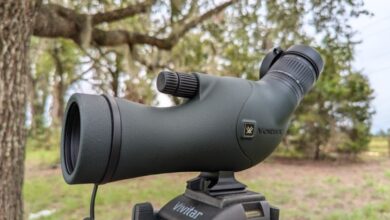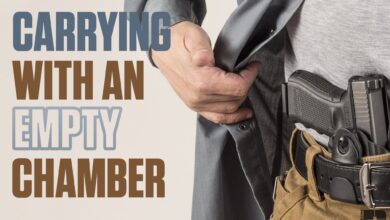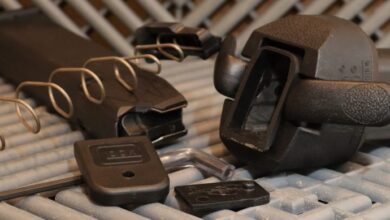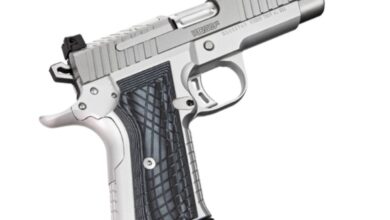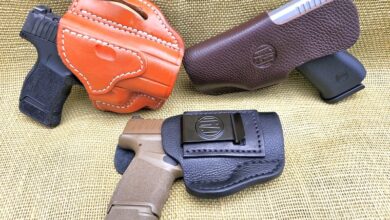Airsoft & Firearms Training: Valuable or Dangerous Gimmick?
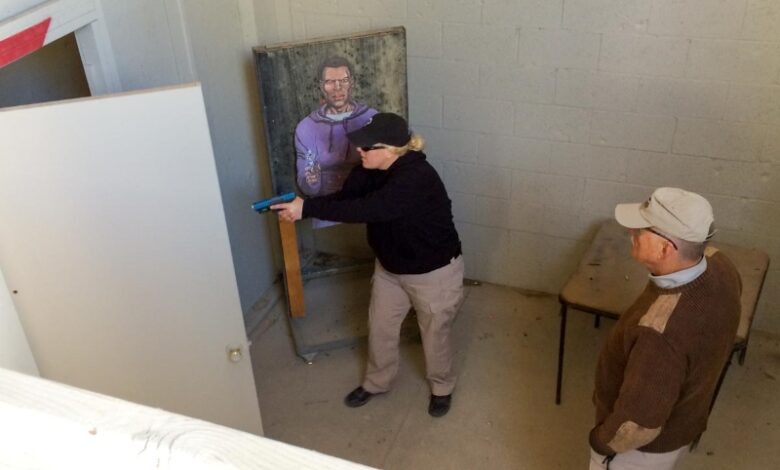
What’s your training regimen like? Many people go to the shooting range a few times a year. They robotically bang away at stationary paper targets on a square range with no time constraints. After the magazine is empty, they leisurely reload it and go back to methodically banging away at the target with an emphasis on taking their time to get the best score possible. Typically, no speed reloads or tactical reloads are practiced. Very few engage in any shooting drills.
Despite that, many people pat themselves on the back, proclaiming that they are “ready” in case the balloon goes up. They believe that taking a full minute to expend a magazine against a target that is holding perfectly still has prepared them for defense or combat. Consider that for a moment and realize just how out of touch some folks are.
Professional Training
Even through my law enforcement career, I was on a square range for annual qualifications, firing at stationary targets. We had time constraints (they were not very constrictive), and we did have to reload our revolvers within that time. There was no movement with the handguns or shotguns. That was for basic line staff.
Tactical training was different in that it introduced a lot of movement. Simunitions were sometimes used as well, especially during Hostage Rescue Team training. During sniper school, moving targets were used. Shooting during movement with teams was also practiced, and sometimes, we found ourselves shooting past each other with shotguns. There was a lot of practice because we couldn’t afford to make a mistake.
The problem with simunitions is that they were expensive to use. Simunitions utilize a small charge (usually the primer) to fire a plastic bullet filled with dye out of a specially modified firearm. Those rounds are going a couple hundred feet per second, and they hurt. Not just a little, either; they leave some major welts, and depending on where the person is hit, they can cause some injuries.
Despite that, we wanted more training and practice, never being satisfied that we’d done enough. Working with live ammunition during team movement kind of does that for you. You have an innate yearning to get better at it.
Real-World Training
Reality is not the square range. When you are engaged in any sort of combat, the opponent will be jumping around like a chimpanzee on crack, just as you will be. It has something to do with not wanting to be punched/stabbed/shot. In real life, the target will be incredibly hard to hit since the subject(s) will be jumping around.
People talk about shot placement, which sounds really cool, but try hitting specific targets on a dynamically moving attacker. I guarantee that you’ll be ecstatic if you can simply land rounds on that attacker. Consider that even police have a hit rate in actual shootings that is well under 30% nationally. That’s pretty horrible, but there it is, that’s reality. So, over 70% of shots fired by police go past the target and keep traveling.
In actual shootings, the average range is within three yards, takes approximately three seconds, and expends about three rounds; it’s the 3-3-3 Principle. Despite reality, we see people practicing at 25 yards and further, which is very unrealistic. But then, their time constraints and the amount of ammo they expend in training are also wildly unrealistic.
One principle to realize is that “He who hits first often wins.” This is true whether we’re talking about fists, knives, or guns. It’s not 100%, but it’s pretty high.
Another point of reality: People don’t just fall down and die right away most of the time when they’re shot. The only way to stop them instantly is to hit the Central Nervous System (CNS), which means the spinal column or the brain. The next most reliable way is to put holes in their circulatory system so their blood pressure drops enough that they lose consciousness, but that takes a lot more time. These aren’t my opinions; they are facts.
Force On Force
We’ve established that shooting stationary targets on a square range isn’t ideal for preparing us for combat. And I classify “Combat” as an instance where someone is trying to harm or kill us or our loved ones.
So what can we do?
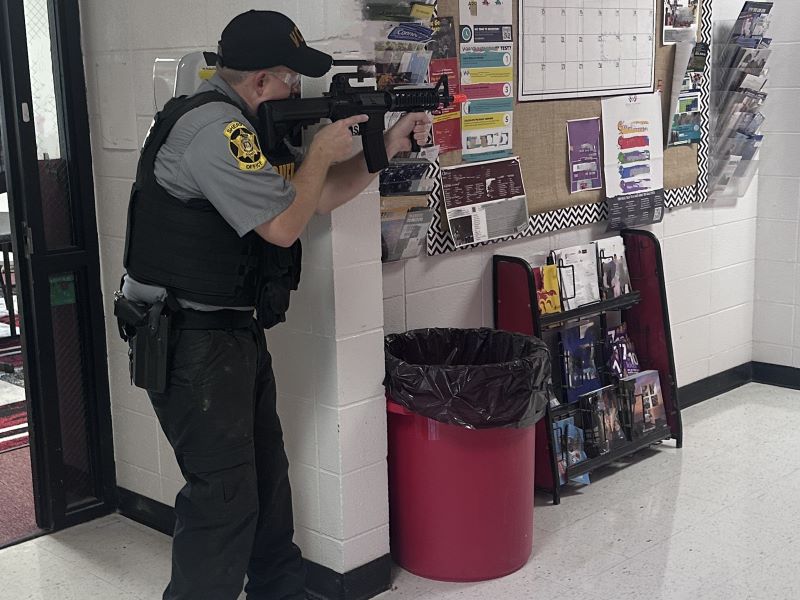
Force on Force training is the answer. In other words, pitting yourself against other humans who are trying to hit you. Boxers box. Martial artists spar. Shooters shoot. We practice by doing what it is we’re trying to accomplish.
The first time that I participated in Force On Force training, my mind was blown. Some revelations were that it was really hard to hit that guy who didn’t want to be shot, and he was moving and using cover just like I was. How dare he do that! He needs to stand out there so I can shoot him! Yeah, that wasn’t happening!
One thing that shocked me was how accurate I actually was when shooting. Another point worth noting is that the attacker(s) was cunning, trying to trip me up and muddy the waters.
Changing Up the Scenarios
We engaged in various scenarios. One scenario involved two cars. I started out in the rear vehicle to simulate having just run into the back of the car in front of me. The angry driver that I’d just hit stormed out of the vehicle, raving like a madman. It was my job to try to de-escalate and deal with him. As we were interacting, he lunged and stabbed me in the stomach with a training knife as I shot him with my Airsoft pistol. So, while he might have died from being shot, I was still stabbed. Things unfolded very quickly.
This brings us to another point: The bad guy knows what he’s going to do before we do, so we are playing catch-up. Action usually beats reaction, and so we come back to the point I brought up earlier: he who hits first often wins. Expect the unexpected.
Another scenario: I had to approach my vehicle and get in to drive away in a parking lot. As I approached, there were a few people milling around my vehicle. As I engaged them and had my attention on them, a madman with a gun emerged from a nearby building and engaged me. I probably would have shot him first, except that my Airsoft pistol was out of gas, so it would not fire. As a result, I was stitched up my right side with several Airsoft BBs (that stung!).
Those BBs feel like bee stings when they hit, which provides a real incentive for us not to get hit. Of course, they’re preferable to getting hit with real bullets.
These were just a few of the scenarios we went through in that particular class, and they were a real eye-opener. After each scenario, we debriefed to determine what was done correctly and where we crashed and burned.
Advantages and Drawbacks
Advantages
- BBs and gas are inexpensive.
- The guns themselves are not very expensive.
- Far cheaper than buying real ammunition and guns.
- Non-lethal.
- They’re quiet and can be used near populated areas without the police coming.
- Can be used indoors.
- Shooting drills can be practiced.
- Good for safely introducing new shooters to the discipline.
Drawbacks
- Limited range.
- Can cause eye injuries if protection is not used (USE EYE PROTECTION!).
Before engaging in any training, it’s important to ensure that NO REAL FIREARMS have made it into the training area. I can’t emphasize this enough, especially given that many Airsoft guns perfectly resemble their real-life counterparts.
Types of Airsoft Guns
There are a few different types of guns available.
One utilized a spring and must be cocked between each shot. Another variety uses a battery-powered mechanism to fire projectiles. Finally, some use gas, which can be from CO2 cartridges or “Green Gas,” which is a form of propane.

The Green Gas guns are neat because they cycle the action like a real firearm, although the recoil is normally less than that of a real gun. In fact, Airsoft guns usually weigh less than their real counterparts. During the training that I was involved with, we used Green Gas Glock 19 replicas, and they represented the real thing relatively accurately, with the limitations mentioned above.

The range of Airsoft guns is limited, and you can’t expect to be hitting things accurately 40 yards away. It’s a close-in proposition, with 50 feet being a realistic expectation.
Most Airsoft pistols and rifles have the same magazine dimensions as their real counterparts, so standard mag pouches can be used for training. The same goes for pistol holsters.
There are replica guns from most of the manufacturers, including Glock, Smith & Wesson, Sig Sauer, Heckler & Koch, and many others.
Who Uses It?
When people think of Airsoft, they often picture kids playing with these guns or “wannabes” playing military games. And those activities can certainly be fun.

However, these tools are used by actual military operators and law enforcement agencies now. Civilians can also run scenarios with Airsoft guns. The training possibilities are endless, and they really are tools.
Closing Thoughts
As long as training scenarios are well thought out and parameters are set, Airsoft guns can be a valuable training tool that takes us well beyond the square range.
In the long run, they can be a very cost-effective way of conducting force-on-force training that will build real-world skills and open the eyes of the participants. You won’t realize how huge this is until you actually engage in FOF training and go up against another living, breathing human. When you do, the light bulb will click on above your head, and your abilities will rapidly expand.
Just realize that there are some limitations, such as the range of the Airsoft guns and the fact that they don’t act exactly as their real counterparts. However, they are close enough to be useful.
Be certain to use safety gear like shooting glasses and ensure that no real, live weapons are involved. And be prepared to experience some fun during the training!
The post Airsoft & Firearms Training: Valuable or Dangerous Gimmick? appeared first on The Mag Life.
Read the full article here


